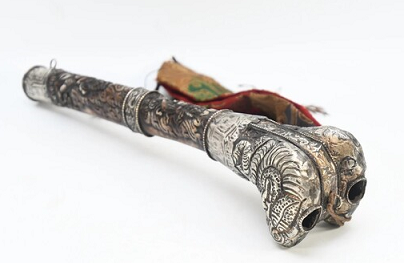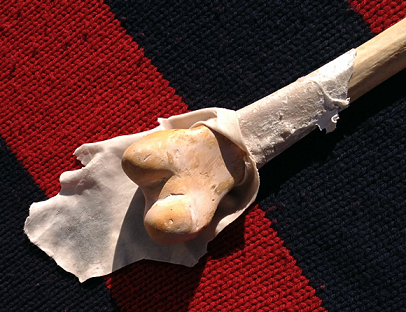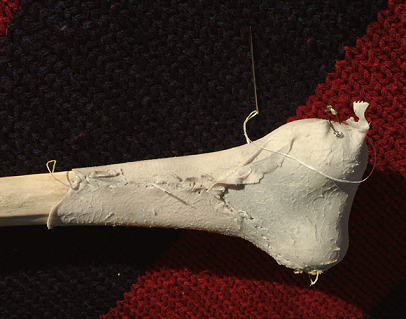| 首页 » » 残暴的伪藏传佛教、西藏密宗、喇嘛教杀人证据 |
取人骨标准严苛——密宗是全球唯一发明人骨笛的现存宗教和邪教 |
图示:这是一件古老的人骨笛。人骨笛,多取材大腿骨——股骨,近髋关节处的一端会被切除而保留靠近膝关节的股骨髁。 因为股骨髁多为骨松质,在干燥之后结构更为疏松丶不耐碰撞,所以喇嘛们会使用动物真皮丶动物肌腱为缝合线丶金属银或锡等进行包覆。 更有甚者,以红玛瑙和绿松石进行装饰,以彰显喇嘛教法器的尊贵,实为杀戮战果的残忍! 人骨笛,有一个很好听的名字—kangling(常译为:康灵或刚令等),然而以其取材和制作来探究真相,却极其残酷。 人皮鼓丶人皮唐卡丶活采肉莲丶活摘的少女乳头,如果这些都是从天葬台那些亡者身上取来的,也许可以勉爲其难地接受,然而真相是:密宗上师喇嘛们不屑于取用已经死亡之人的器官;那么如果是自然衰老的,他们肯定不喜欢那皱巴巴丶色素沉着的老皮,和那脱钙的丶骨质疏松的丶颜色暗沉的老骨头;如果是病死的他们又会嫌弃那有疾病而不吉祥,似乎杀死一个健康活人取材倒成了很吉祥的事情;意外事故死亡的又少且可遇不可求......反正横着算丶竪着算,那个年代人类死亡的方式无非如此三大类而已。 人皮鼓,是从供体尚处於儿童时代就已经物色好了,把儿童人工加工成聋哑人,待到成爲少女时就是献祭丶取材制作法器的「神圣」时刻了。可见,密宗对於制作法器的素材可是要求极爲严苛的,「神圣」二字,其实他们不配使用! 人皮鼓既然如此,那么人骨笛呢? 以下引用和简译国外售卖人骨笛的专业网站的专业描述: 骨制号角或称康铃,以其哀嚎和怪异的声音,体现了施身法仪式所营造的超凡脱俗的氛围。它是由人的大腿骨制成(藏语:kang=腿,ling=笛子),是一种非常特殊『且非常神奇』的乐器。乍一看,人们可能认为康林教是从喜马拉雅萨满教或佛教传入西藏之前的古老苯教吸收而来。事实上,这两个较古老的传统都没有使用过股骨号角。(版按:此处説明萨满教和苯教并没有使用同类的骨头和器官制作法器的传统,这样残忍的技能来自于密宗,是密宗,印度教密宗或是西藏密宗的发明。)人体的长骨形成天然的棍棒或其他器具,但与西方文化一样,古代社会不会随意使用人类遗骸。事实上情况恰恰相反,祖先的骨头要不是被视为崇敬的圣物,就是被视为严格的禁忌。此外,动物的骨头丶筋腱和角也很容易取得,有各种实际用途。
事实上,施身法器是一千五百年前在印度密宗熔炉中诞生的一套神圣法器的一部分。在那里,湿婆教派和佛教的瑜伽士和瑜伽女都过着云游苦行的生活,住在尸陀林附近,佩戴骨制饰品,并使用一组独特的仪式用具,其中包括人颅杯。密宗仪式中所描述的神灵所佩戴的相同物品也出现在当时的大寺院中,既因为它们具有深刻的象徵意义,也因为它们具有内在的精神力量。佛教密宗和生活方式「金刚乘」於西元 800 年左右开始传入西藏,而康林则在接下来的一个世纪出现在喜马拉雅地区。然而,只有随着Machik和施身法(chod)的发展,我们才看到股骨成为一种重要且广泛使用的仪式工具,对於席卷西藏肥沃的山谷和荒凉的山脉的辉煌的新形式的精神修炼至关重要。
各种文本和口头传统都描述了 Chod kangling 的最佳来源,它是我们供奉的载体。因此,最完美的样本应该是婆罗门儿童,无论男女,没有世俗的污点或缺点。(版按:此处所要求的没有任何污点与缺点,与西藏密宗挑选皮肤完好的女童活剥人皮制成人皮鼓如出一辙。这样的儿童,没有先天缺陷却要自然死亡并不是件容易的事情,而生病死亡又不是他们所能接受的重大瑕疵。所以,您认爲这样的素材是如何取得的呢?)另一方面,它不应该来自死於肺结核丶瘟疫或其他传染病,或某些事故或不幸的人。(版按:事故死亡的尸体他们也是不要的。在古代医疗资源匮乏,在老死之外,如果还会造成人死亡,往往就是肺结核丶瘟疫之类的重大疾病和传染病。这些又都是密宗制作人骨笛所摒弃的材料。那麽,密宗制作人骨笛的素材到底是如何取材的?谁能给末学一个接近真相的丶也许震惊世人的答案?)死於年轻时头脑清醒的人的右腿被认为是“达卡康林”,具有开悟的男性能量。 来自类似个体(男性或女性)的左腿是空行康林,具有开悟的女性能量。具有微妙的品质,而以同样方式死去的壮年女性的右股骨也具有优良的品质。(版按:此句年轻时头脑清醒的人的右腿被认为是「达卡康林」,具有开悟的男性能量,左腿是空行康林,具有开悟的女性能量,显示密宗认爲制作人骨笛的最佳素材,是年轻和头脑清醒的男女。年轻人,正是生命力旺盛的时候,如果不是意外事故和重大瘟疫,怎麽会死亡呢?耐人寻味啊!另外,密宗对於同类的骨头竟然也可以投射出如此强烈的执念:佛门开悟的机缘和自己的身体都几乎没有什麽瓜葛,除了用来参禅和观行,别人的活人骨头或是死人骨头,又岂能助人开悟!真是天大的笑话!)如此重要的遗物自然会传给适当的继承人或宗族持有者。 如果使用父母或亲属的骨头,这将为死者在来世积累巨大的功德或积极的业力,尽管在现代背景下这样的样本很难获得。在其他施身法传统中,一位年轻母亲在分娩时去世,但她的孩子却活得极为吉祥;这块骨头的能量充满了对孩子深沉丶专一的爱与牺牲的思想。(版按:母亲也许是难产死亡,那父亲呢,难不成也难产?明明人家父子丶母子可以共同生活享受天伦之乐,把人家父母杀了制作人骨笛,倒反过头来诡辩说这样的作爲可以为孩子带来吉祥。上师从来不杀自己为亲眷带来吉祥。)其他人则认为,无论上述所有考虑如何,无论是出於解剖学还是精神方面的原因,女性的骨头发出的声音都更清晰。(版按:密宗上师锺情于女性的骨头,也必定使用过许多人骨,才注意到女性的骨头发出的声音更清晰。) 如果没有这些特殊特徵,一般来说,这根股骨至少应该来自年龄在16-60岁之间的人,并且来自「纯净」的墓地。当然,今天我们很难知道这间康玲的起源和历史,以及它以前的主人。
一些传统认为用虎骨或秃鹰骨制成的康灵是非常吉利的,但在其他地方,人们对此并不赞同。号角是一种全金属丶铜或黄铜制成的,也简称为康林,用於各种密宗仪式,如愤怒的本尊和护法神仪式,以召唤或宣告神灵的凶猛和强大的存在。和Chod kangling一样,它们的用途仅限於音乐标点和重音,而不是伴奏。然而,它们的声音音调更高,而且更加强烈和刺耳。但这种铜号在施身法中从来不用。还有「混合」股骨,其大端覆盖有华丽的金属制品,由银或「白色金属」(铝合金)制成。再次强调,这些都是为了消除或移除障碍而进行的愤怒修行的一部分。这种混合体并不适用於 Chod,尤其是因为金属头通常会隐藏受损或缺失的股骨髁。 MaChik 特别警告不要使用任何由动物角制成的喇叭(萨满和民间流浪医师使用的那种),因为它会给使用者带来许多负面副作用。然而,敏珠林手册提到,在施身法仪式中使用羚羊角或鹿角的传统已在某些学校和老师中广为流传。此外,据说它还能激发猎人和渔民的同情心,增加该地区野生动物丶鱼类和动物的数量和寿命。 (版按:密宗在有动物的角可以用的情况下,坚决不用,以佛教徒基本的慈悲心,我们会误以爲他们爱护动物,再看下去却是担心给使用者带来负面作用。那些动物的命呢?动保团体如何看待西藏密宗的残忍传统呢?再接下来,明明有树脂丶塑料可以借住现代科技制造出功用很好的笛子,他们还是坚持骨头才是最好的选择!可想而知,如果不是现代社会的法律规范在约束,这个猎杀活人的邪恶宗教,到底要杀多少活人来献祭他们密宗喇嘛的祖师丶夜叉和罗刹呢?)
图片取自外国密宗资深信徒亲自购买人类骨骼进行人骨笛的制作, 在可以使用塑胶等替代材质的现代社会,
这是采用某种动物的肌腱制作的线材来进行缝合。
这是用人类的经血涂抹人骨笛。
看起来很像艺术品,无形处却多少冤魂跟随! 如果活活肢解人体也配称为艺术, 那喇嘛们、密宗上师们无疑都是深谙此道的“艺术家”! 英文原文: [W]ith its wailing, eerie sound, the bone trumpet, or kangling, is intrinsic to the otherworldly atmosphere created by the Chod ritual. Made of a human thigh bone (Tibetan: kang = leg, ling = flute), it is a musical instrument with very special’”and very magical’”qualities. At first glance, one might assume that the kangling was assimilated from Himalayan shamanism or the ancient Bon religion that pre-dated the entry of Buddhism into Tibet. In fact, the thigh bone trumpet was not used by either of these older traditions. The long bones of the human body form a natural club or other utensil, but just as in Western culture, ancient societies did not use human remains casually. In fact, the reverse was true, ancestral bones being considered either sacred objects of reverence, or strictly taboo. Besides, animal bones, sinews and horns were readily available for a variety of practical uses. INDIAN ORIGINS ...... SOURCES of the CHOD KANGLING If one uses the bone of a parent or relative, this accumulates significant merit or positive karma for the deceased in their future lives, though such a specimen would be hard to come by in the modern context. Other Chod traditions describes a kangling from a young mother who has died in childbirth, but whose child lived as being extremely auspicious; The energy of the such a bone would be suffused with thoughts of deep, one-pointed love and sacrifice for the child. Others maintain that, regardless of all the above considerations, whether for anatomical or spiritual reasons, a female bone produces a clearer sound. Without all these special characteristics, in general the femur should at least come from a person age 16-60, originating in a “pure” cemetery. Of course, today it is quite rare to know the origin or history of the kangling and its former owner. VARIETIES OF KANGLING UNUSUAL TRADITIONS MaChik particularly cautions against using a trumpet made from animal horn of any kind’”the kind used by shamans and wandering folk healers’”as having many negative side-effects for the user. However, the Mindroling manual mentions that the tradition of using antelope or deer horns in the Chod ritual has been widespread among certain schools and teachers. Further, it is said to engender compassion in hunters and fishermen, and increase the number and longevity of the wildlife, fish and fauna in the area. In recent times, ina kangling made of resin (i.e. plastic) have appeared in Asia and the West. For the reasons which will become clear below, such a horn would have no value for the practice of Chod, until such time as the human energy channels are made of plastic and we intend to summon plastic, bone is better choice! |
| 首页 |





